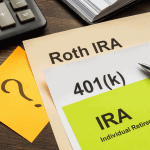Understanding the IRS Rule
Effective in 2024, the SECURE 2.0 Act permits employers to contribute to an employee’s retirement plan, such as a 401(k) or 403(b), based on the employee’s student loan payments. This innovative approach means that even if employees are financially unable to contribute to their retirement accounts due to the burden of student loans, they can still receive employer contributions, fostering both student debt repayment and retirement savings growth.
How the Plan Works
- Employee Enrollment: Employees with student loans opt into this benefit, allowing their student loan repayments to count towards qualifying for employer matching contributions.
- Making Student Loan Payments: Employees continue to make their regular student loan payments.
- Employer Contributions: Based on these payments, employers make a matching contribution to the employee’s retirement plan, just as they would match a traditional contribution to a retirement savings plan.
Tax Benefits
For Employees, this setup offers a dual advantage. Firstly, it facilitates growth in retirement savings without requiring direct contributions to their retirement plan, which can be particularly beneficial for those struggling with student loan debt. Secondly, since employer contributions to retirement plans are not considered taxable income for the employee, this can effectively reduce their overall tax burden.
For Employers, the contributions made to employee retirement plans are typically tax-deductible, reducing the company’s taxable income. Additionally, offering this benefit can enhance a company’s benefits package, making it more attractive to prospective and current employees.
Qualifying Factors and Limitations
- Qualifying Payments: Not all student loan payments may qualify for this benefit. Payments must be towards the principal or interest of a qualified student loan for the employee’s education.
- Plan Participation: Employers must amend their retirement plan documents to offer this benefit, adhering to specific guidelines and regulations set forth by the IRS and the Department of Labor.
- Contribution Limits: The total contributions (including both employee contributions and employer matching for student loan payments) must not exceed the annual IRS limits for retirement plan contributions.
- Documentation and Compliance: Both employers and employees must maintain thorough documentation of student loan payments and corresponding employer contributions to ensure compliance with IRS requirements and to qualify for tax benefits.
Real-Life Scenario: How the SECURE 2.0 Act Works
Imagine Emily, an employee with a $50,000 annual salary, who is diligently paying off her student loans while dreaming of a financially secure retirement. Like many, Emily faces the tough choice between paying down debt and investing in her future.
Here’s how the SECURE 2.0 Act transforms her financial strategy:
Without the SECURE 2.0 Act
- Situation: Emily prioritizes her student loan payments of $300 per month, sidelining retirement contributions.
- Impact: Despite her best intentions, Emily misses out on her employer’s retirement match, stunting her retirement fund’s growth.
With the SECURE 2.0 Act
- Student Loan Payments: Emily continues her $300 monthly student loan payments, totaling $3,600 annually.
- Employer Contributions: Thanks to the SECURE 2.0 Act, these payments qualify her for her employer’s match in her 401(k), just as if she had made the contributions herself.
- Outcome: Emily’s employer contributes $2,500 to her 401(k) based on her student loan payments, fostering her retirement savings without additional financial strain.
Conclusion
The SECURE 2.0 Act offers a beacon of hope for individuals like Emily, providing a dual-path approach to financial well-being. By aligning student loan payments with retirement savings growth, the act ensures that employees do not have to choose between their present and future financial security. This example underscores the act’s potential to transform the financial planning landscape, making the goal of a secure retirement more accessible to those grappling with student debt.





